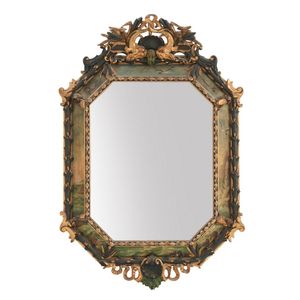An antique Italian cushion mirror in Mid-Eighteenth century…
An antique Italian cushion mirror in Mid-Eighteenth century style, second half 19th century, the octagonal bevelled plate in a receding frame decorated to a marine theme, its gilt and black crest of entwined grotesque fish around a shell centre above mouldings of shells and foliage, the lower centre of a shell and ribbons, the border panels of the frame painted with coastal scenes with boats and sea birds, 117 cm high, 80 cm wide, 14 cm deep. provenance: lady Primrose potter, AC
You must be a subscriber, and be logged in to view price and dealer details.
Subscribe Now to view actual auction price for this item
When you subscribe, you have the option of setting the currency in which to display prices to $Au, $US, $NZ or Stg.
This item has been sold, and the description, image and price are for reference purposes only.
- Grotesque - Grotesque decoration is any fanciful ornament applied to furniture and decorative arts, and includes distorted faces, mythical animals such as satyrs and sphinxes and less frequently fantastical fruit and flower forms.
The Martin Brothers who set up their pottery at the end of the nineteenth century in Southall, Middlesex derived their fame from their hand made models of grotesque stoneware birds. - Bevel / Chamfer - In furniture making, a chamfered corner refers to a technique used to create a smooth, angled edge on the corner of a piece of furniture. This is typically done by cutting away a small portion of the corner at an angle, typically 45 degrees, creating a diagonal edge, rather than a sharp 90-degree angle. This technique can be used on various parts of a piece of furniture such as table legs, drawer fronts, or door frames. Chamfering can add visual interest to a piece and can help to soften the overall look of a piece of furniture. It is often used in conjunction with other techniques, such as rounding edges or using contrasting wood species to create a more elegant, sophisticated look. Chamfering is a simple way to add a touch of elegance to a piece of furniture and it is a common technique used by furniture makers.
- Mouldings - Decorative strips, deriving from architectural features, that may be either applied separately to a piece of furniture or worked directly on to the carcase. Mouldings are found on cornices or pediments, around the edges of panels and drawer fronts, and around both the tops and bottoms of chests, bookcases and other cabinet furniture. Until the late 19th century mouldings were worked by hand, using a shaped moulding plane. Latterly, they have been shaped by machine.
- Provenance - A term used to describe the provable history of an antique or work of art, and thus an additional aid to verifying its authenticity. Provenance can have an inflating effect on the price of an item, particularly if the provenance relates to the early settlement of Australia, a famous person, or royalty. Less significant are previous sales of the item through an auction house or dealer.
- Panels - Timber pieces, usually of well-figured wood either recessed or applied over the frames of doors and as decoration elsewhere in the carcase of cabinet furniture. The panels may take a variety of shapes rectangular, square, shield shape, oval, half-round or in the form of Egyptian pylons.
This item has been included into following indexes:
-
mirrors, wall, period, age or style
- cushion style 112
- Louis style 361
